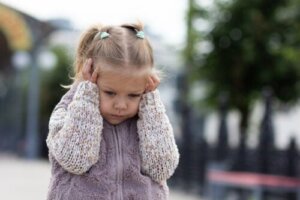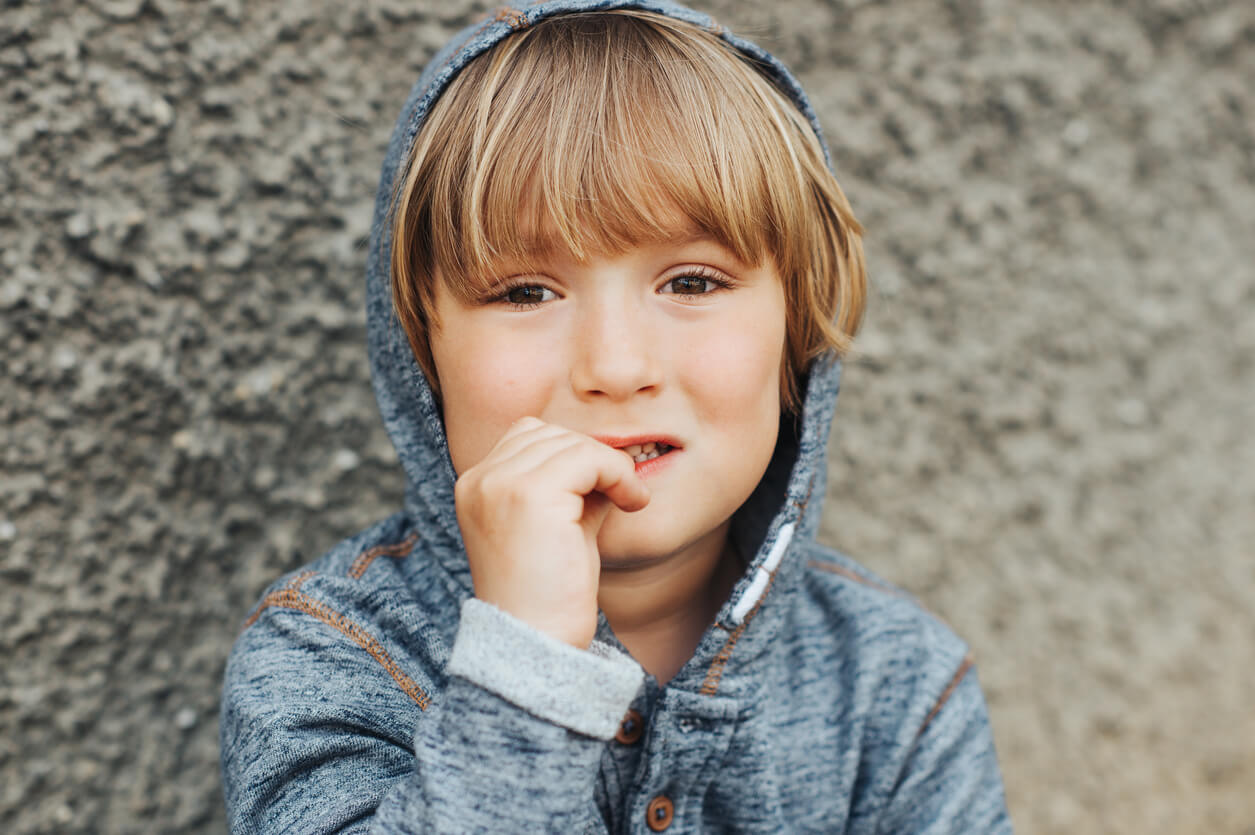Dissociation in Children and Adolescents


Written and verified by the psychologist Maria Fátima Seppi Vinuales
Faced with a shocking situation, you may imagine that you’ll react in a certain way. However, when that moment arrives, you may be surprised by your own response. Sometimes the circumstances overwhelm your ability to act in one direction. This is how defense mechanisms work. Below, you can find information on how dissociation in children and adolescents works.
What is dissociation in children and adolescents?
In general terms, dissociation refers to a separation or disconnection from reality. It’s usually associated with situations of trauma and high stress, which is why it’s triggered as a defense mechanism. In this regard, children and adolescents are exposed to an experience that they can’t tolerate or resolve and, to protect themselves, the body and mind disconnect and distance themselves from the event.
What situations can lead to dissociation in children and adolescents?

Some of them could be the following:
- Being a victim or witness of violence.
- Abuse situations.
- Experiences of neglect and abandonment.
- An upbringing based on fear and threat.
- Traumatic events, such as an accident (being a witness or victim), among others.
- Chronic bullying.
You may be interested in: Insecure Attachment: Characteristics and Consequences
The symptoms of dissociation in children and adolescents
Some of the most frequent signs of dissociation in children and adolescents are the following:
- Amnesias: There are mental gaps regarding certain episodes. The child or adolescent doesn’t remember having been present and doesn’t recognize themself as part of an event where other people do.
- “Going blank”: Very similar to the previous point, when a child experienced an episode of violence, perhaps they go blank. It’s like being in the place, but without being there. At that moment, this “going blank” was functional and defensive. However, dissociation can also intrude into other areas of life and can lead them to disconnect from other situations. Undoubtedly, this affects their participation, enjoyment, and also their learning and performance.
- Unrelated or unexplained emotions: It often happens that children or adolescents report feeling sad or anxious but are unable to identify the source.
- Emotional numbness: No situation triggers an emotion.
- Psychosomatic expressions: Many times, this repression or concealment of the trauma leads the mind to “turn off”. However, this discomfort persists and seeks a way to manifest or transform itself. How does it do so? For example, through spots or allergies on the skin. Also, through regressive behaviors (children go back to wetting the bed at night or sucking their thumb, among other things).
- Nightmares or sleep-related difficulties: For example, adolescents may wake up in the middle of the night frightened by a bad dream. Or they may not be able to go back to sleep. In the case of children, there may also be nightmares and fear of sleeping with the light off, among others.
- Risk behaviors: Especially in adolescents. This may occur in the form of unprotected sex, drug abuse, speeding, and others.
You may be interested in: How to Detect Psychological Abuse in Children

How to deal with dissociation in children and adolescents?
Beyond the signs of dissociation, it’s always important to take into account the history and context of the child or adolescent. This is the key to understanding what’s happening to them and when it’s a behavior caused by a trauma or a temporary behavior that’s to be expected in their evolutionary stage. Knowing this child is what will allow us to evaluate and understand their behavior.
Some of the recommendations to take into account with dissociation in children and adolescents are the following:
- Create a space for respectful and caring dialogue. Try to offer an affectionate environment, active listening, and empathy. Allow them to think, feel, and express their emotions.
- Validate emotions. When faced with complex situations, there’s no universal way to resolve them. Each person does what they can with the resources they have. Many children and adolescents don’t recognize themselves and don’t understand what’s happening to them. As an adult, you must be able to help put a name to it and support them on the path of discovery.
- Help them connect with the here and now. Relaxation techniques and mindfulness, adapted to different ages, are very useful. These serve to help children and adolescents to connect, be present, focus their attention, and keep their mind from disconnecting.
- Ask a professional for help. Sometimes a child or adolescent’s pain in the face of a traumatic situation is far more than an adult can address without the right tools.
Accept in order to move on
Over time and with help, children and adolescents should be able to turn their pain into resilience. In this way, they’ll be able to emerge stronger from adversity. New conditions can be created, as well as acceptance, forgiveness, and healing. In order to do so, a support network will be necessary to accompany and sustain them. This network must be able to offer care and a vision of learning and optimism about life.
Faced with a shocking situation, you may imagine that you’ll react in a certain way. However, when that moment arrives, you may be surprised by your own response. Sometimes the circumstances overwhelm your ability to act in one direction. This is how defense mechanisms work. Below, you can find information on how dissociation in children and adolescents works.
What is dissociation in children and adolescents?
In general terms, dissociation refers to a separation or disconnection from reality. It’s usually associated with situations of trauma and high stress, which is why it’s triggered as a defense mechanism. In this regard, children and adolescents are exposed to an experience that they can’t tolerate or resolve and, to protect themselves, the body and mind disconnect and distance themselves from the event.
What situations can lead to dissociation in children and adolescents?

Some of them could be the following:
- Being a victim or witness of violence.
- Abuse situations.
- Experiences of neglect and abandonment.
- An upbringing based on fear and threat.
- Traumatic events, such as an accident (being a witness or victim), among others.
- Chronic bullying.
You may be interested in: Insecure Attachment: Characteristics and Consequences
The symptoms of dissociation in children and adolescents
Some of the most frequent signs of dissociation in children and adolescents are the following:
- Amnesias: There are mental gaps regarding certain episodes. The child or adolescent doesn’t remember having been present and doesn’t recognize themself as part of an event where other people do.
- “Going blank”: Very similar to the previous point, when a child experienced an episode of violence, perhaps they go blank. It’s like being in the place, but without being there. At that moment, this “going blank” was functional and defensive. However, dissociation can also intrude into other areas of life and can lead them to disconnect from other situations. Undoubtedly, this affects their participation, enjoyment, and also their learning and performance.
- Unrelated or unexplained emotions: It often happens that children or adolescents report feeling sad or anxious but are unable to identify the source.
- Emotional numbness: No situation triggers an emotion.
- Psychosomatic expressions: Many times, this repression or concealment of the trauma leads the mind to “turn off”. However, this discomfort persists and seeks a way to manifest or transform itself. How does it do so? For example, through spots or allergies on the skin. Also, through regressive behaviors (children go back to wetting the bed at night or sucking their thumb, among other things).
- Nightmares or sleep-related difficulties: For example, adolescents may wake up in the middle of the night frightened by a bad dream. Or they may not be able to go back to sleep. In the case of children, there may also be nightmares and fear of sleeping with the light off, among others.
- Risk behaviors: Especially in adolescents. This may occur in the form of unprotected sex, drug abuse, speeding, and others.
You may be interested in: How to Detect Psychological Abuse in Children

How to deal with dissociation in children and adolescents?
Beyond the signs of dissociation, it’s always important to take into account the history and context of the child or adolescent. This is the key to understanding what’s happening to them and when it’s a behavior caused by a trauma or a temporary behavior that’s to be expected in their evolutionary stage. Knowing this child is what will allow us to evaluate and understand their behavior.
Some of the recommendations to take into account with dissociation in children and adolescents are the following:
- Create a space for respectful and caring dialogue. Try to offer an affectionate environment, active listening, and empathy. Allow them to think, feel, and express their emotions.
- Validate emotions. When faced with complex situations, there’s no universal way to resolve them. Each person does what they can with the resources they have. Many children and adolescents don’t recognize themselves and don’t understand what’s happening to them. As an adult, you must be able to help put a name to it and support them on the path of discovery.
- Help them connect with the here and now. Relaxation techniques and mindfulness, adapted to different ages, are very useful. These serve to help children and adolescents to connect, be present, focus their attention, and keep their mind from disconnecting.
- Ask a professional for help. Sometimes a child or adolescent’s pain in the face of a traumatic situation is far more than an adult can address without the right tools.
Accept in order to move on
Over time and with help, children and adolescents should be able to turn their pain into resilience. In this way, they’ll be able to emerge stronger from adversity. New conditions can be created, as well as acceptance, forgiveness, and healing. In order to do so, a support network will be necessary to accompany and sustain them. This network must be able to offer care and a vision of learning and optimism about life.
All cited sources were thoroughly reviewed by our team to ensure their quality, reliability, currency, and validity. The bibliography of this article was considered reliable and of academic or scientific accuracy.
- Rodríguez Vega, B., Fernández Liria, A. y Bayón Pérez, C. (2005). Trauma, disociación y somatización. Anuario de Psicologia Clinica y de la Salud/Annuary of Clinical and Health Psychology, 1, 27-38.
- Cazabat, E. H. (2004). Evolución histórica del concepto de disociación. Revista de psicotrauma, 3(1).
- Romero – López, M. (2016) Una revisión de los trastornos disociativos: de la personalidad múltiple al estrés postraumático. Anales de Psicología, vol. 32, núm. 2, mayo, 2016, pp. 448-456. Universidad de Murcia
This text is provided for informational purposes only and does not replace consultation with a professional. If in doubt, consult your specialist.








